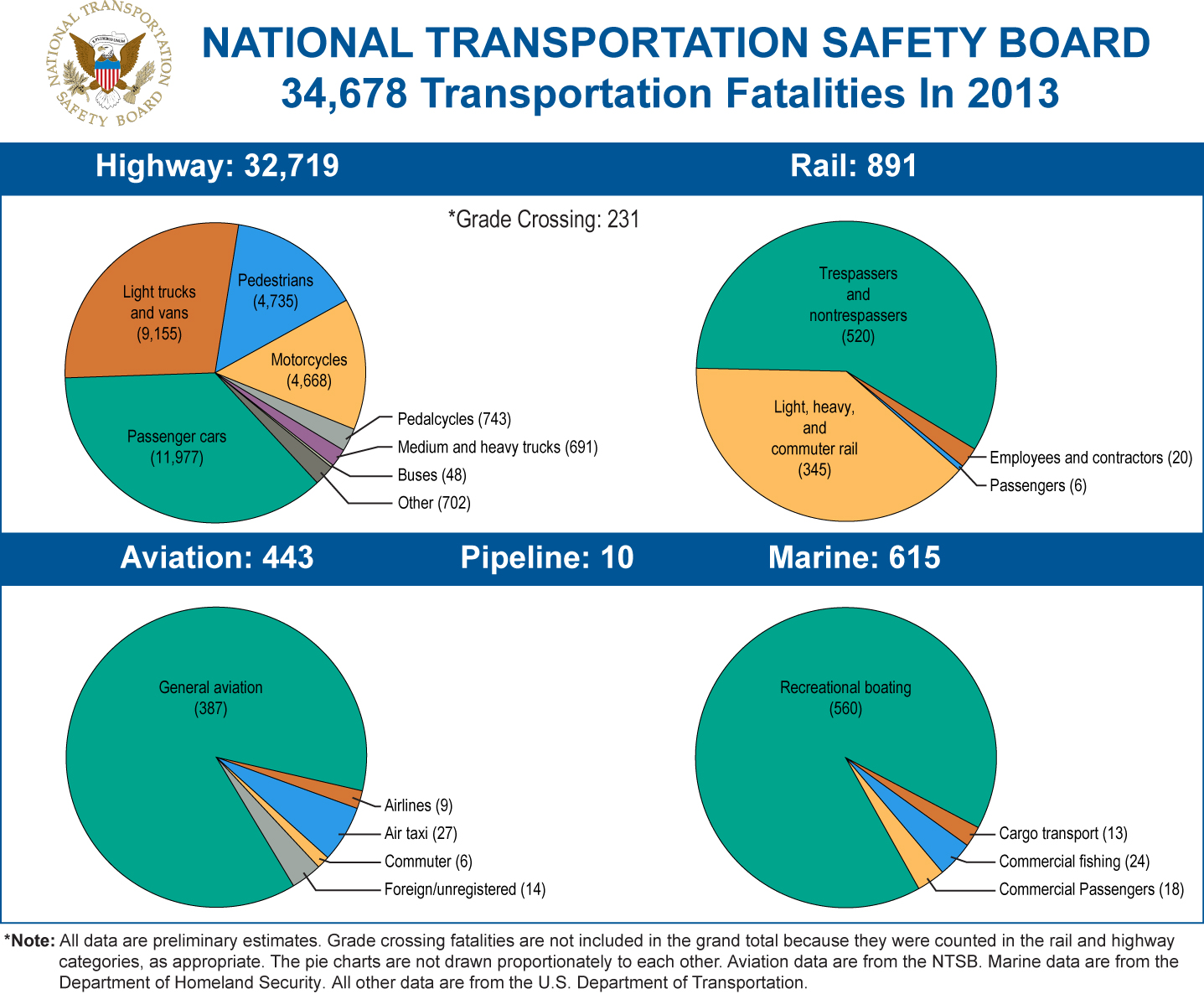A column in The Week argues that notwithstanding Tuesday's horrific crash of a Metro-North train that killed five passengers, rail is a much safer mode than driving. However, rail deaths are increasing.
"It's true that there are lessons to be drawn from the crash [see below NTSB pie charts] — but not ones that imply we should avoid using passenger trains," writes Jacob Anbinder," a policy associate at The Century Foundation, a New York-based think tank. "If anything, the Valhalla incident shows just how far we've come on train safety, and also what we must do to keep improving."
While all signs point to error by the motorist as the cause, the crash has already prompted more hand-wringing about the safety practices of the Metro-North, which were criticized by the Federal Railroad Administration last year.
Amid the hundreds of news reports and searing images of the train's burnt-out carcass, it's easy to forget just how ridiculously safe it is to travel by rail in this country.
Anbinder reminds us that "(o)ver the last 15 years, just 55 [train] passengers were killed compared to the 60 or so automobile drivers and passengers who die in car crashes every day."
Counting "death by train" can be tricky. According to Progressive Railroading:
Railroad deaths increased 6 percent from 840 in 2012 to 891 in 2013, the vast majority of which were trespassers struck by trains, they said. Trespasser and non-trespasser fatalities totaled 520, while commuter-, heavy- and light-rail fatalities totaled 345. Employee and contractor deaths numbered 20, and passenger deaths totaled six.
A press release from the National Transportation Safety Board (NTSB) issued the day before the Valhalla crash is titled: "Slight Drop in 2013 Transportation Fatalities in Most Categories; Rail Deaths Rise."
- Railroad deaths increased 6 percent from 840 to 891. The vast majority of these fatalities continue to be trespassers struck by trains.
- U. S. roadway deaths, which account for nearly 94 percent of all transportation deaths, decreased from 33,782 in 2012 to 32,719 in 2013.

Credit: NTSB
NTSB inspectors at the Valhalla crash site are attempting to determine why "the electrified third rail dislodged from the tracks and entered the lead car," according to CBSNewYork.
Metro-North is the only rail line in the country to use "a bottom-contact third rail," as opposed to a top-contact third rail, they write. "The nose piece slopes down to catch the 'shoe' that touches the rail for power," the implication being that the impact caused the shoes to lift the rail and penetrate the first car.
Hat tip to Angie Schmitt of Streetsblog.
FULL STORY: Why the Metro-North crash should encourage more people to take the train

Maui's Vacation Rental Debate Turns Ugly
Verbal attacks, misinformation campaigns and fistfights plague a high-stakes debate to convert thousands of vacation rentals into long-term housing.

Planetizen Federal Action Tracker
A weekly monitor of how Trump’s orders and actions are impacting planners and planning in America.

In Urban Planning, AI Prompting Could be the New Design Thinking
Creativity has long been key to great urban design. What if we see AI as our new creative partner?

King County Supportive Housing Program Offers Hope for Unhoused Residents
The county is taking a ‘Housing First’ approach that prioritizes getting people into housing, then offering wraparound supportive services.

Researchers Use AI to Get Clearer Picture of US Housing
Analysts are using artificial intelligence to supercharge their research by allowing them to comb through data faster. Though these AI tools can be error prone, they save time and housing researchers are optimistic about the future.

Making Shared Micromobility More Inclusive
Cities and shared mobility system operators can do more to include people with disabilities in planning and operations, per a new report.
Urban Design for Planners 1: Software Tools
This six-course series explores essential urban design concepts using open source software and equips planners with the tools they need to participate fully in the urban design process.
Planning for Universal Design
Learn the tools for implementing Universal Design in planning regulations.
planning NEXT
Appalachian Highlands Housing Partners
Mpact (founded as Rail~Volution)
City of Camden Redevelopment Agency
City of Astoria
City of Portland
City of Laramie


























